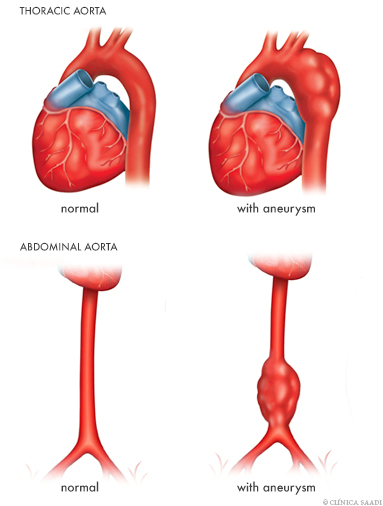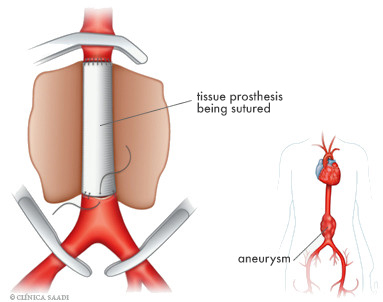Cardiovascular system Aortic aneurysms
The aneurysm is a dilation located on the wall of a blood vessel. The aneurysms can be formed in any artery in the body, such as the iliac, femoral, popliteal, and visceral ones, including the brain ones. However, they are more common to be developed in the aorta, the largest artery in the body. The aneurysms can be developed in any portion of the aorta: thoracic and/or abdominal. The most common place for aortic dilation is in its abdominal portion, just below the renal arteries.
There are two main forms for treating aortic aneurysms: conventional and endovascular surgeries

In the conventional technique, there is need for opening the thorax or abdomen and to temporarily interrupt the blood flow in this segment of the aorta, for the dilated portion to be able to be replaced with a tissue prosthesis that is sutured (sewed) at the place. There is need for general anesthesia and, as the procedure is large-sized, the intestine stays paralyzed for some days, the recovery is slower, and the hospitalization time is longer.

In the endovascular process (also called as implantation of endoprosthesis), small incisions from 3 cm to 4 cm are made at the groin area to gain access to the femoral arteries instead of large incisions on the thorax or abdomen. The endoprosthesis is inserter through such small incisions by a catheter by the femoral artery until the aneurysm place, where it is released.

The blood flow is redirected once the endoprosthesis is released, so excluding the aneurysm from the circulation. These endoprostheses are fixated inside the aorta by their radial force or small hooks. The endoprosthesis reinforces the weakened portion of the aorta in order to prevent the aneurysm rupture. These prostheses are made of a metallic alloy called as nitinol or steel, which has high resistance and malleability, and are covered by tissue (Dacron or PTFE). The procedure cam be performed with regional anesthesia (peridural or epidural blockade) or even with local anesthesia. As the procedure is well less invasive, the risk is lower and the recovery is faster. However, it is not exempt of risks. The patient must remain in follow-up after the procedure, undergoing periodical tomographies, mainly to be certain of the correct positioning of the endoprosthesis and to verify the occurrence of endoleaks (blood leakage between the endoprosthesis and the aneurysm). We are still waiting to evaluate the long-term results.

